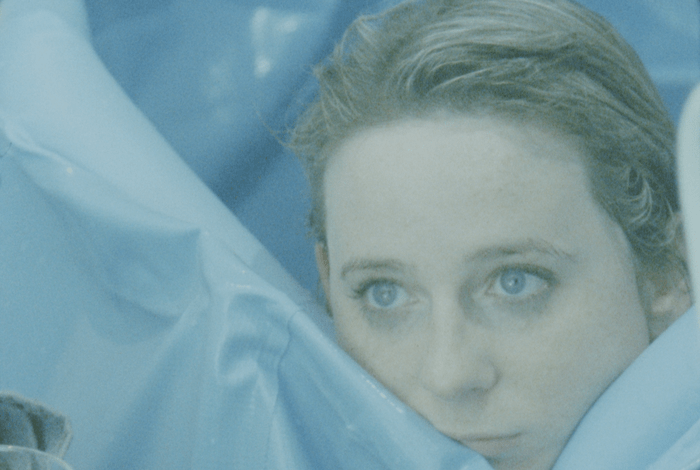Open call for experimental essays – Metode vol. 2
Being, Bathing and Beyond
.
This open call for experimental essays begins with a film. Quoted above is the queer, disabled, London-based artist Abi Palmer in the film On Being and Bathing (2021), made in collaboration with Anna Ulrikke Andersen. Looking at Abi’s bathroom and her inflatable bathtub, the film asks how she navigates the spaces she inhabits, uncovering what it might mean to want to become more fluid – or more like water.
Using the film as a point of departure, this open call asks participants to tackle related themes through their own artistic, academic, or architectural research practice. Although encouraged to go beyond, a few ideas that spring from the film can be helpful:
What does it mean to be in water? In her book The Architecture of Bathing: Body, Landscape, Art (2020), Christie Pearson considers bathing as a form of physical knowledge of architecture and social relations. Barbara Penner’s Bathrooms (2013) traces the history of bathrooms, and with it, how our understanding of disability has changed over time.
What is the critical and creative potential of the disabled body? Architect Jos Boys and the DisOrdinary Architecture Project offers a shift away from understanding the disabled body as a legal and technical problem, to recognizing the potential that comes with navigating a world that is not built for you. What further theoretical support can be found in the field of disability studies and disability arts?
Can the making of films (or other artistic practices) in itself be a way to explore the spatial manifestations of exclusion and/or inclusion? Lucia Nagib looks at the notion of physicality and difference in the work of Werner Herzog. He considers filmmaking as an athletic endeavor that engages the body. Could other approaches to time-based media, or artistic research more generally, make us consider the history of art, architecture, design, cities, and even landscapes, differently? What techniques do we employ? Does it matter what equipment we use?
What else can we find if we go beyond – beyond conventions of bodies and buildings, and research thereof?
The Oslo-based platform ROM for kunst og arkitektur – the publisher of Metode – has worked strategically with these concerns for a number of years by launching open calls and organizing Norway’s first summer school in art and architecture for young disabled people. This volume of Metode opens up for new ways of approaching how a diverse set of bodies engage with and experience our built environment, as well as larger societal structures that perhaps should be challenged and changed.
The call invites scholars and practitioners to watch the film and then to go beyond: to pick up on an idea, a theme, a feeling, or a sensation to delve into in their own unique way. We welcome all forms of artistic research, alongside more traditional formats of written text: historical or theoretical.
Submission
We seek experimental essays that are intellectually rigorous, visually compelling, and methodically innovative. We encourage a consolidated research framework driven by cocreation, in which theorists and practitioners closely collaborate in the conceptualization, writing process, and visual experimentation.
Submit full essays by 14th of August 2023 to metode@r-o-m.no. The experimental essays could be between 2000 and 5000 words.
All submissions will be evaluated by Metode’s editorial board. If accepted, the authors will undergo an in-depth, transparent, and stimulating peer review process with the editorial board and affiliated scholars. This process will take place as three hybrid workshops in September, November, and December 2023. Final contributions will be published in Metode in January and February 2024.
Editor of Metode vol. 2 is architectural historian and filmmaker Dr. Anna Ulrikke Andersen, Associate Professor at The Norwegian University of Science and Technology.
About Metode
The online journal platform Metode publishes essays in the fields of art and architecture. The essays are developed through experimental, intellectual co-creation, and collaborative methods. The journal’s open, in-depth peer review method aims to offer theorists and practitioners a discursive platform for generating original and compelling critical thinking on art, architecture, design, and aesthetics that challenge conventional academic publication formats and disseminations.
We invite artists, designers, and architects to unite with scholars from the humanities to explore creative and risky ways of assembling knowledge through words and works.
Metode is run by ROM for kunst og arkitektur: Ingrid Halland (founder and editor-in-chief), Gjertrud Steinsvåg (project leader), and Solveig Tjetland (editoral assistant). The editorial board consists of Victoria Bugge Øye, Gustav Jørgen Pedersen, Anna Ulrikke Andersen, Sara Yazdani, and Marie-Alix Isdahl.
Read the latest issue of Metode on the topic of Deep Surface here:
https://metode.r-o-m.no/en/volume/1
Metode was launched in 2022 with generous support from the Norwegian Ministry of Foreign Affairs.
